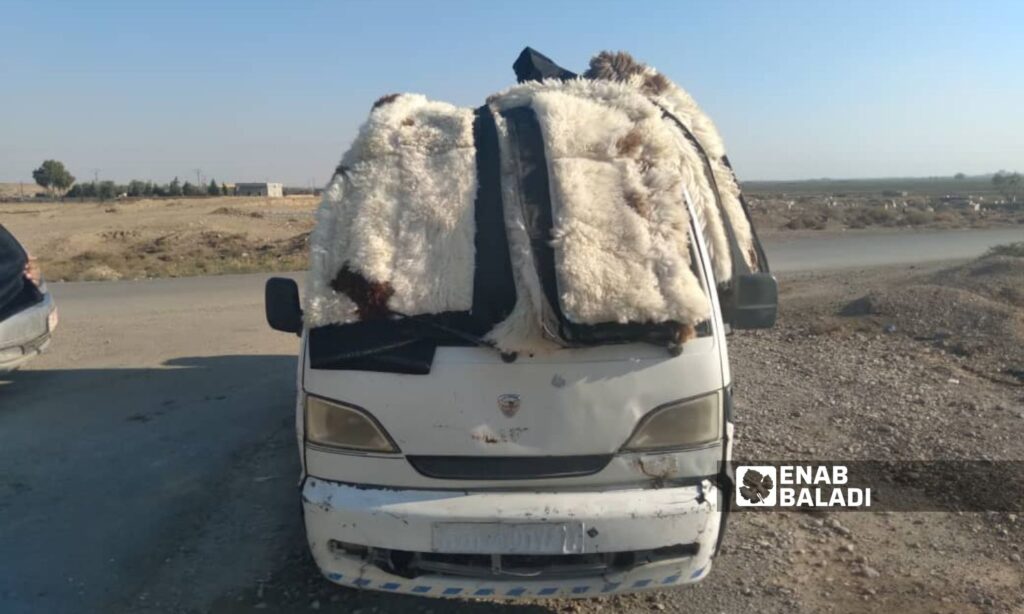Deir Ezzor – Obadah al-Sheikh
The sight of wearing farwa coats in the villages and towns of Deir Ezzor, eastern Syria, does not go unnoticed. This traditional garment is favored by locals as winter arrives.
The wearing of farwa is not limited to the elderly; young people and children also embrace it, and hardly a household in Deir Ezzor exists where its members do not wear farwa coats.
Farwa is considered a popular dress that provides a high degree of thermal insulation. However, its production has declined in the region, with pieces sold in US dollars.
Prices based on quality
Farwa is a garment made from the skin and wool of young lambs, commonly known in the region as “Sakhlah” and “Fatimah,” which do not exceed two months of age, as described by Mustafa al-Saeed, a 65-year-old, to Enab Baladi.
He added that in recent years, there has been an increase in the interest of youth and even children in wearing farwa, which is no longer exclusive to the elderly as it used to be.
Hamdi al-Kardoush, a fabric and farwa trader in the outskirts of Deir Ezzor, told Enab Baladi that there are various types of farwa; some are made from the skin and wool of sheep, and their value is linked to the age of the sheep. Some are called “Kabashi,” made from the hides of older sheep.
The trader mentioned that prices range from 15 US dollars (225,000 Syrian pounds) to 500 dollars, typically sourced from the city of Aleppo, Manbij, or sometimes from Damascus.
He added that the production of farwa has evolved, incorporating golden threads and designs that attract customers and keep up with fashion trends, increasing the demand among the locals. However, its production does not see wide popularity in the region.
“Unprofitable” industry
The craft of making farwa in Deir Ezzor is an inherited profession passed down through generations, yet not many people are skilled in it, nor do many young people pursue it.
Dib al-Mukhlef (Abu Khaled), a workshop owner in the town of Muhaymidah in western Deir Ezzor, shared with Enab Baladi that he has worked in the farwa-making profession he inherited from his father and grandfather for years.
He stated that the craft has developed; previously, it was solely made from sheep skin, but now various fabrics have been incorporated, such as velvet, synthetic leather, English “Harbed” fabric, and Indian fabric.
The “Harbed” and “Indian” types are among the highest quality, tailored to custom orders from customers due to their high cost, according to al-Mukhlef.
“Harbed” is not widely available in the markets, while the “Indian” fabric can be sourced from factories in Raqqa, and local furs are acquired from butchers in the area.
Regarding the workshop’s operations, he noted that the farwa-making profession does not yield as much profit for the workshop as it does for the traders; what the workshop earns is barely enough to meet the family’s needs.
Focus on design
Trending farwas in the markets are often made of synthetic leather, according to Junaid al-Halabi, a fabric trader in the outskirts of Deir Ezzor.
He mentioned to Enab Baladi that some farwas are made of velvet due to their acceptable price of 15 dollars (about 250,000 Syrian pounds), compared to “Harbed” farwas, which cost around 200 dollars. He indicated that young people prioritize design over quality and type.
He added that previously, farwas were made solely from sheep wool and skin in black, but with the introduction of synthetic wool, more types and colors have been added, including brown and its shades, silver, gold, and navy blue. He noted that sales have been good, especially with the onset of November.
Many traditional professions and popular garments remain present in Deir Ezzor and are still in circulation today, including the craft of reed mat production, which many still practice while preserving it, considered one of the most notable summer crafts for many.
These professions provide a source of income for families; workers earn 25,000 Syrian pounds daily, despite the long working hours, amid the region’s economic decline and the decrease in purchasing power among locals due to the plummeting value of the Syrian pound against the US dollar (each dollar equals 15,000 Syrian pounds).
Mobile gypsies or “nawar” are also active, working in professions such as tooth extraction and treatment, offering their services at lower prices, although they perform unlicensed and low-quality work.

